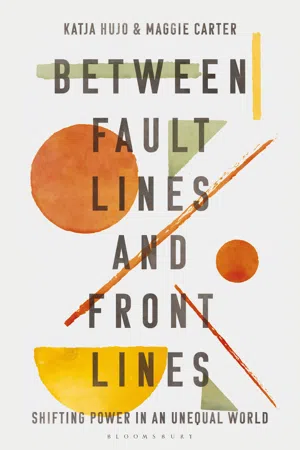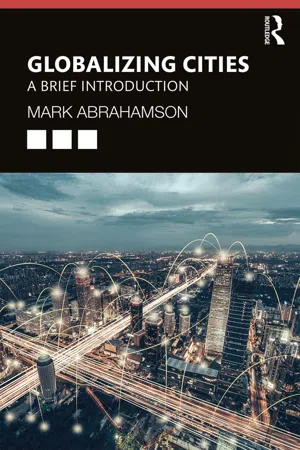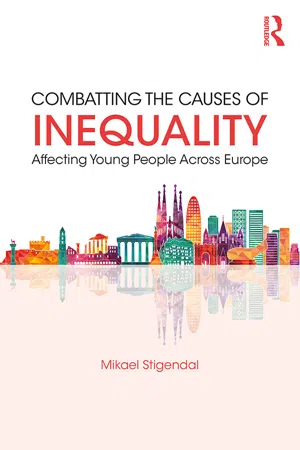Equity and Inequality
Equity refers to fairness and justice in the distribution of resources and opportunities, while inequality refers to disparities in these distributions. In geography, equity and inequality are studied in relation to access to resources, land use, and socio-economic conditions within and between different regions. Understanding these concepts helps geographers analyze spatial patterns of development and identify areas in need of intervention.
5 Key excerpts on "Equity and Inequality"
- eBook - ePub
Rethinking Economic Policy for Social Justice
The radical potential of human rights
- Radhika Balakrishnan, James Heintz, Diane Elson(Authors)
- 2016(Publication Date)
- Routledge(Publisher)
...But equally important, expanding inequalities raise important questions of what is fair and just. The human rights framework, as one approach to evaluating economic and social outcomes with regard to social justice, must engage with the question of inequality—how much, if any, inequality is acceptable, and what limits does growing inequality place on the fulfillment of basic rights? Approaches to understanding inequality When people speak of inequality, they often have in mind an unequal distribution of income or wealth. However, people experience inequalities across a number of dimensions. There are inequalities in educational attainment, in health, and in the distribution of power. The free time men and women have is unequally distributed, once all demands for work, both paid work on the job and unpaid work at home, are taken into account. Inequalities in income and wealth are associated with other disparities. For instance, low-income households have worse health outcomes on average (Subramanian and Kawachi 2004). Furthermore, inequalities can be measured with respect to different units of society—between individuals, between households, between social groups (e.g. race, gender, and ethnicity), and between countries. The emphasis in this chapter is on inequalities in income and wealth between individuals, households, social groups, and countries—and the relationship of these inequalities to human rights. Inequality can be defined in various ways and the generic term “inequality” actually reflects a range of distinct inequalities. One important distinction is between “horizontal inequality” and “vertical inequality.” Horizontal inequality is defined as inequality between culturally defined or socially constructed groups. Inequalities with respect to gender, race, ethnicity, religion, caste, and sexuality are all examples of horizontal inequalities. Vertical inequality refers to inequality between individuals or between households...
- eBook - ePub
Between Fault Lines and Front Lines
Shifting Power in an Unequal World
- Katja Hujo, Maggie Carter, Katja Hujo, Maggie Carter(Authors)
- 2022(Publication Date)
- Bloomsbury Academic(Publisher)
...By pointing to the massive disparity represented in these numbers and juxtaposing these two groups as forces positioned against each other, it made a clear argument: the inequalities we are facing globally, regionally, nationally and locally are not a natural and unavoidable reality of our world order, but rather a result of choices made within entrenched power structures and global economic systems. This is where a select few, the 1 percent, have highly disproportionate control over and access to resources, and therefore over decisions. This situation is reinforced by the current economic order, which distributes gains toward capital owners to the detriment of labor and the environment (UNCTAD 2020; Jomo and Popov in this volume). As elites gain a prominent foothold in political processes, whether directly or indirectly, they often act to preserve and perpetuate a system that benefits the few at the expense of the many, halting the possibilities for equitable redistribution. Drawing on case studies from North America, Latin America, Africa and Europe, Part II of this volume reveals the various ways in which inequality is a compounding and self-reproducing process and explores the power imbalances, girded by economic dominance, that are at the heart of this cycle, from the very local to the transnational levels. Inequalities often come to a head most visibly at the local level, spaces in which those at either end of the spectrum engage with each other on a daily basis, mediated through various forms of power relations and social, spatial and economic barriers. In Chapter 3, Julie MacLeavy and David Manley explore the intergenerational transmission of inequalities from a geographical perspective. The chapter offers insights into the production and reinforcement of spatial divides between and within population groups in Western postindustrial nations...
- eBook - ePub
Development Economics
Theory and Practice
- Alain de Janvry, Elisabeth Sadoulet(Authors)
- 2021(Publication Date)
- Routledge(Publisher)
...It is not clear, however, that the policy implications of addressing equity bring in much that was not there before in the pursuit of development. Equity is defined as equality of opportunity for success: it is an ex ante concept relative to outcomes. Equity requires level playing fields so development outcomes for individuals depend only on their levels of effort and on luck, not on particular circumstances such as their initial individual characteristics, asset endowment, and context. The World Development Report 2006 documents the fact that there are massive inequities attached to gender, race, caste, place of birth, parental education, paternal occupation, and parental socioeconomic status. According to Roemer (2013), the traditional utilitarian “equality approach” to development consists of equalizing outcomes such as income, wages, and life expectancy. By contrast, an “equal opportunity approach” to development equalizes outcomes only at equal levels of effort. It requires equalizing the role of circumstances on outcomes at given effort. Alternatively, it requires eliminating inequalities that are due to circumstances for which persons should not be held responsible as they are beyond their control. But why should policy be concerned with equity in development? There are two reasons: one intrinsic, the other instrumental. The intrinsic value of equity is the broadly shared feeling that egregious disparities of opportunity violate a sense of fairness, particularly when the individuals affected can do little about them. For Rawls (1971), this can derive from a self-serving concern that if we do not know where we will fit in the distribution of opportunities, due to what he called the “veil of ignorance,” we should a priori prefer a more egalitarian distribution of opportunities...
- eBook - ePub
Globalizing Cities
A Brief Introduction
- Mark Abrahamson(Author)
- 2019(Publication Date)
- Routledge(Publisher)
...When the focus is upon how groups that are geographically separated from each other differ in terms of income or wealth, then segregation can be regarded as a spatial representation of inequality because these economic differences are almost invariably associated with multiple differences in opportunities, or life chances. It is often difficult for analyses to remove the effects of non-economic variables that also affect both residential segregation and opportunities. The racial-ethnic composition of a city or nation is obviously such a variable. Nevertheless, income and wealth inequality have been found to be the major correlates of the extent of socioeconomic residential segregation. In the United States, for example, size of the Gini index, by itself, has been found to explain over one-half of all the variation in residential income segregation among metropolitan areas. 19 The most widely utilized measure of segregation is probably the index of dissimilarity. It expresses the degree to which any two groups are similarly distributed across the neighborhoods or census tracts that comprise the larger geographical area, usually a city or metropolitan area. It calculates the percentage of people in one group who would have to change locations for the two groups being compared to be identically distributed. To illustrate with respect to high- and low-socioeconomic groups: a dissimilarity index of.39 would indicate that 39% of the people or households in the low-socioeconomic group would have to move to a high-socioeconomic group neighborhood for the two income groups to share the same spatial distribution. 20 The possible values of the index range from 0 (no movement necessary because the two groups are totally integrated) to 100 (indicating that they are totally separated). Neither of these extremes scores have been empirically obtained, though...
- Mikael Stigendal(Author)
- 2018(Publication Date)
- Routledge(Publisher)
...2 What is inequality? Inequality is “one of the most pressing issues of the day”, Michael Burawoy, president of the International Sociological Association, said in his welcome address to the World Congress of Sociology in 2014 with the title “Facing an unequal world”. The World Economic Forum, in its Global Risks Report 2017, ranks inequality first among the risks to the global economy and the underlying trends that will determine the shape of the world in the next decade. As the OECD Secretary General Angel Gurria wrote in his editorial to the report Divided we stand. Why inequality keeps rising (OECD, 2011: 17), “inequality has become a universal concern, among both policy makers and societies at large”. He then went on and mentioned the huge difference in incomes between the rich and poor. That is obviously an inequality, about which scholars like Anthony Atkinson, Branco Milanovic and Thomas Piketty (2014) have vastly expanded the empirical knowledge. Corresponding achievements have been made by epidemiologists like in particular Michael Marmot (2015) and Richard Wilkinson & Kate Picket (2009), focusing on inequality in terms of health (WHO, 2008). What have these inequalities in common? What makes them inequalities? What else is inequality? What should we mean by inequality? First of all, inequality is a word; in itself it also has certain properties. Something exists which we have decided to call inequality and the name of it puts us on a certain track to an understanding of it. Similarly, the word poverty tends to direct us, but more narrowly, to focus on the poor. There is nothing inevitable in the word ‘poverty’ which makes us become interested in the rich. To be sure, our wider perspective may certainly motivate such an interest, but the single word poverty does not...




